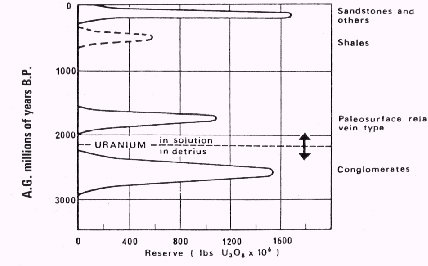
The First Atmosphere—Geological Evidences and Their Implications
Originally published in Creation 3, no 4 (November 1980): 46-52.
In Ex Nihilo (v3n3, August 1980) David Denner discussed the composition of the Earth’s primitive atmosphere as advocated by evolutionists.
He concluded that:
The reason for the widespread adherence to the belief in a primitive reducing atmosphere, in spite of much evidence to the contrary, is the same reason for which it was postulated. If you are to believe many of the theories of chemical evolution at all, you simply have to believe the Earth’s atmosphere was once radically different from its composition today.
Most geologists accept the assertion that the early Earth had a reducing atmosphere. The concept that the Archaean (> 2.3 billion Arbitrary Geologic Years (A.G.Yr.3) atmosphere contained practically no free oxygen has had its roots in the threefold division of the geological column based on abundance of macrofossils: Phanerozoic (Cambrian to Recent), Oroterozoic, and Archaean. Lack of obvious Archaean life has popularly been attributed to a hostile environment rich in toxic, reduced volcanic gases. Lack of Archaean sulfates and red beds has similarly been attributed to peculiar atmospheric and hydrospheric compositions. These arguments have been convincingly presented by scientists such as Cloud,1, 2 Eriksson and Truswell,3 and Schidlowski.4 The strongest support for an oxygen-poor Archaean atmosphere came with Holland’s5 calculation of the maximum partial pressure of oxygen for uraninite (UO2) stability, and his interpretation that the Archaean uraninite placer deposits of the Witwatersrand, South Africa, and Elliot Lake, Canada, could not have formed under a significantly oxidizing atmosphere. This was followed by a variety of genetic models for the formation of the ubiquitous Archaean banded iron formations, such models depending upon an oxygen-poor atmosphere.6, 7, 8, 9
However, there is now substantial evidence against these interdependent concepts. Dimroth and Kimberley10 unequivocally state:
In general, we find no evidence in the sedimentary distributions of carbon, sulfur, uranium or iron, that an oxygen-free atmosphere has existed at any time during the span of geological history recorded in well preserved sedimentary rocks (emphasis mine).
They went on to explain that:
The sedimentary distributions of carbon, sulfur, uranium, and ferric and ferrous iron depend greatly upon ambient oxygen pressure and should reflect any major change in proportion of oxygen in the atmosphere or hydrosphere. The similar distributions of these elements in sedimentary rocks of all ages are here interpreted to indicate the existence of a Precambrian atmosphere containing much oxygen.
Elsewhere11 they concluded:
We know of no evidence which proves orders-of-magnitude differences between Middle Archaean and subsequent atmospheric compositions, hydrospheric compositions, or total biomasses.
Sedimentary carbon
Dimroth and Kimberley10 found that:
Organic carbon contents and distributions are similar in Precambrian and Quaternary sedimentary rocks and sediments, although distributions in both would have been sensitive to variations in rates of organic productivity and atmospheric oxygen pressure.
Carbon occurs in two ways in sedimentary rocks:
(a) within the carbonate radical of carbonate minerals, and
(b) in a myriad of organic compounds. The latter is termed organic carbon and is the decay product of living matter. It is found even in Archaean rocks.11 Organic carbon compounds are found in virtually all well preserved shales and mudstones of any age.10
Abundant Archaean organic carbon is a residual product of photosynthetic oxygen production. Microorganisms have been reported from carbonaceous rocks of the Fig Tree Group of Swaziland (3.4 billion A.G.Yr. old)12 and blue-green algae remains occur in the 2.6 billion A.G. Yr. old Veal Reef Carbon Seam of the Witwatersrand Sequence.13 Archaean and Lower Proterozoic shales and mudstones sampled to date average 0.7 wt % and 1.6 wt. % organic carbon respectively.14 This compares with the average amount of 0.5 wt. % organic carbon in Phanerozoic shales and mudstones.15
Furthermore the spatial pattern of Archaean—carbon distribution does not differ in any obvious way from that of the Late Precambrian or Phanerozoic.11 This rules out the possibility that Archaean sediments repeatedly survived weathering and resedimentation cycles as a result of any postulated low rate of atmospheric oxygen production. An even stronger argument against this recycling of organic carbon is the strong correlation, obvious in the field, between organic carbon and pyrite (FeS2) contents in all Precambrian sedimentary rocks, particularly in Archaean rocks.10 Since diagenetic pyrite formation depends upon the presence of readily metabolizable organic compounds,16 it is clear that this organic carbon was in organic matter not long dead at the time of deposition.
Not only is the mass distribution of carbon between organic molecules and carbonate minerals relevant to atmospheric oxygen levels but also isotopic fractionation between these two reservoirs.17 In the hydrosphere-atmosphere system comparable organic and carbonate carbon isotopic ratios in sedimentary rocks of all ages would indicate a consent rate of separation between the two reservoirs, and hence an unchanging rate of free oxygen production. Available analyses indeed indicate constancy with time for the isotopic ratios of sedimentary carbonate and organic carbon.18, 19, 20, 21 After discounting the effects of additional carbon supplied in volcanic emissions, Demroth and Kimberley10 still concluded that:
The constancy of carbon isotopic fractionation in sedimentary rocks is, in fact, an indication of relative constancy of free-oxygen production.
And thus the composition of the Archaean atmosphere was similar to that of the present day atmosphere.
Sedimentary sulfur
Kimberley and Dimroth11 found that:
The distribution of sulfur in Archaean and Proterozoic rocks is similar to that in Phanerozoic rocks of comparable type.
The distribution of sulfur in recent sediments, like that of organic carbon, is largely a function of primary and diagenetic redox reactions16 and is correspondingly sensitive to variations in atmospheric oxygen pressure. There are two major sources of sulfide sulfur in present-day sediments—seawater sulfate reduced bacterially and organic sulfur released during decay; and two minor sources—volcanically exhaled sulfur and detrital pyrite.
The preservation potential of detrital pyrite in present day sedimentary environments is now being eliminated largely by biochemical oxidation and oxidative corrosion. In a few cases, detrital pyrite may survive diagenesis, provided deposition is rapid and reducing biogenic conditions are established rapidly after deposition. By contrast, pyrite should have been a consistent and important component of sediments deposited under a hypothetical oxygen-deficient atmosphere. Pyrite is common in all source rocks but detrital pyrite is just as rare in Proterozoic and Archaean sedimentary rocks as it is in present day sediments. Absence of pyrite from many Proterozoic and Archaean sandstones, for instance, despite the common presence of the mineral in the source rocks, is evidence for oxidation during transport and/or diagenesis.
Part Two
Most sulfide sulfur in recent sediments has formed by the action of sulphate-reducing bacteria and is closely associated with bituminous and carbonaceous shales. Sedimentary pyrite is almost invariably closely associated with organic carbon in sedimentary rocks of any age. Some Precambrian pyrite occurs as laminae like some of the recent diagenetic pyrite,16 but much is nodular, more obviously diagenetic. Carbonaceous snares and mudstones of all ages are richly pyritic and basal sandstones of all elastic sequences are commonly cemented by pyrite.11 Pyrite content increases linearly with increasing organic carbon content in Archaean shales and mudstones, a similar relationship to that seen in sulfur and carbon contents.14 This consistency of the sulfide sulphur-carbonaceous shale/mudstone association, which is so characteristic of Precambrian as well as Phanerozoic rock associations, is evident for:
(a) the continually abundant presence of sulfate in the oceans and
(b) the continual diagenetic bacterial reduction of that sulfate, since deposition of the earliest known Precambrian sediment.10
Volcanic exhalations generally include hydrogen sulfide gas. Under present conditions most of the exhaled hydrogen sulfide is rapidly oxidized and precipitation of heavy metal sulfides occurs only under exceptional conditions. In the presence of atmospheric oxygen, the products of volcanic exhalation would have differed, particularly if it is assumed most of the primordial ocean had been saturated with respect to siderite (FeCO3).7, 8, 9 All hydrogen sulfide exhaled by submarine volcanos would have precipitated as iron sulfide close to the volcanic vents. Volcanoaenic sulfide deposits should be many orders of magnitude more voluminous in Precambrian volcanic sequences than in Phanerozoic volcanic sequences, and they should occur around all Archaean submarine volcanic centers. In fact, none of these or other inferred differences between volcanogenic sulfide deposits of Precambrian and Phanerozoic age are consistently found.10 Massive sulfide deposits certainly did not form around every Archaean volcanic center nor do Archaean sulfide deposits appear to be more voluminous than sulfide deposits in comparable Phanerozoic volcanic belts. The distribution of volcanic exhalation sulfide deposits in Archaean terrains does not appear to differ substantially from the Phanerozoic distribution, and the hypothesis that the Early Precambrian primordial ocean was saturated with respect to siderite is similarly unsubstantiated.10
Scarcity of Precambrian evaporites has been cited as evidence against substantial sulfate concentrations in sea water and an oxidizing atmosphere. However, most Archaean sedimentary rocks are in sequences which do not normally contain evaporites. Most Archaean sedimentation apparently occurred on tectonically active, steep slopes surrounding volcanic piles, a setting not conducive to evaporite deposition or preservation.10 On the other hand, there is now abundant evidence that evaporites were present in many Proterozoic sequences, for example, in Northern Australia.22, 23 Survival of the actual evaporite minerals is claimed to be rare in Precambrian sediments because presently exposed rocks have been fairly close to the surface since the end of Precambrian time and have experienced prolonged groundwater flow. In conclusion, the apparent disproportionate distribution of evaporites between Archaean, Proterozoic, and Phanerozoic sedimentary sequences cannot be used as an argument in favor of a primitive reducing atmosphere.
Uranium
One of the strongest arguments used to support the theory of a primitive reducing atmosphere is the character of uranium deposition, which is presumed to have changed with time, resulting in the apparent time-related or time-bound occurrence of the various types of uranium deposits.24, 25
Based on Holland’s5 calculation of the maximum partial pressure of oxygen for uraninite (UO2) stability, it was concluded that the Archaean uraninite placer deposits of the Witwatersrand, South Africa and Elliot Lake, Canada could not have formed under a significantly oxidizing atmosphere. While controversy regarding the origin of these two deposits has raged for many years, most geologists now accept the placer hypothesis whereby detrital uraninite was deposited in the quartz pebble conglomerates of alluvial fan or placer under reducing atmospheric conditions. It is argued that because the uraninite appears to be detrital and only stable under reducing conditions, then atmospheric conditions, at the time of transport and deposition must have been reducing.25,26 However, the remarkable similarity between the subeconomic concentrations of detrital uraninite in the present day Indus Valley27 and that of the Witwatersrand, as well as other evidence, invalidates any such concept.
It would appear quite unnecessary to postulate a reducing atmosphere for the transportation of detrital uraninite.28
Furthermore, Kimberley and Dimroth10, 11 present evidence against this placer hypothesis, comparing many of the characteristics of other major uranium occurrences undisputably deposited under oxygen-rich atmospheric conditions to those of the Witwatersrand and Elliot Lake ores. Direct evidence of mobility of uranium in solution has been found in uranite-replaced organisms within Witwatersrand ores,29 which negates the case for a reducing atmosphere put by Robertson et al,25 as seen in the diagram.

Dimroth and Kimberley conclude:
Although it is thermodynamically possible that this mobility could have occurred at exceedingly low oxygen pressures, it is more likely that the carbonaceous replacements indicate an oxygenic groundwater atmosphere system more like that at present.10
Similarly Simpson and Bowles28 state:
The retention of sulfate and uranyl ions in solution . . . suggests that the atmosphere was oxidizing at the time of deposition.
In reality, therefore, the distribution of uranium deposits within sediments of all ages has nothing to do with changes in atmospheric conditions which were oxidizing throughout the Phanerozoic, Proterozoic and the Archaean. Rather the distribution is dependent on the availability of uranium in the sediment source rocks.
The high uranium content of crystalline Archaean source rocks is the probable main reason for uranium concentrations in the Lower Proterozoic, Tertiary mantles on uplifted, crystalline Precambrian rocks like the Shirley Basin of Wyoming are similarly rich in stratiform deposits of uraninite.11
Conclusion and implications
Dimroth and Kimberley10 concluded that the distributions of carbon, sulfur, uranium and iron in Precambrian sedimentary rocks are similar to those in Phanerozoic sedimentary rocks, and that therefore the earth’s atmosphere has always been oxidizing. This conclusion is devastating to all theories of chemical evolution which require a reducing atmosphere, and it has important implications for the Biblical creation-flood model.
First and foremost the abundance of organic carbon in so-called Archaean and Proterozoic sedimentary rocks is initially surprising, but also suggests that these rocks, including many metamorphic (ex-sedimentary) rocks, were also deposited during the Biblical Flood. We must remember that the geological column and associated time-scale is itself assumptive, so that flood geology need not be bound to the same depositional order of strata and certainly cannot adopt the same nomenclature and terminology. These organic carbon-rich Archaean and Proterozoic sedimentary rocks contain the remains of life, albeit microscopic life by the myriads, and algae, destroyed in the same catastrophe as the invertebrates and vertebrates of the so-called Phanerozoic. The terms Archaean and Proterozoic only place these rocks early within the evolutionary time-scale, a position rejected by flood geologists.
Secondly, the similar distribution of carbon, sulfur, uranium and iron within sedimentary rocks of all uniformitarian geological ages is in fact more compatible with the flood geology model in which all fossiliferous sedimentary rocks and associated strata were deposited during the Biblical Flood and since. Because the created atmosphere has always been oxygen rich (in the Garden of Eden as well as during the Flood) it is to be expected that the nature and chemistry of the Flood sediments would reflect this.
Thirdly, since Precambrian sedimentary and metamorphic rocks contain globally important ore deposits these same ores were either deposited as an integral part of the enclosing sediments during the Flood, or, as in the case of some uranium ores, formed during or after the Flood following deposition of the sediments which enclose them.
Finally, these conclusions and implications are in direct conflict with the uniformitarian geological time scale. This conflict is highlighted by the many radiometric age dates for these rocks and ores (particularly uranium ores). What I am asserting is that all major fossiliferous strata, regardless of their geologic age, were deposited during the Biblical Flood about 5,000 years ago or consequent to it, and that the evidence is entirely consistent with this thesis.
Footnotes
- Cloud, P.E., Sci. 160 729, (1968).
- Cloud, P.E., Am. J. Sci. 272 537, (1972).
- Eriksson, K.A. & Truswell, J.F., in Evolution of the Earth’s Crust, D.H. Tarling (ed.) ch 6 219, (1979).
- Schidlowski, M., in The Early History of the Earth’s Crust, B.F. Windley (ed.) Wiley, New York, 525, (1976).
- Holland, H.D., in “Petrologic Studies.” Geol. Soc. Am. Buddington 447, (1962).
- Lepp, H. & Goldich, S.S. Exon. Geol. 59 1025, (1964).
- Cloud, P.E., Econ. Geol. 68 1135, (1973).
- Holland, H.D., Econ. Geol. 68 1169, (1973).
- Drever, J.J., Geol. Soc. Am. Bull. 85 1099, (1974).
- Dimroth, E. & Kimberley, M.M., Can. J. Earth Sci. 13 1161, (1976).
- Kimberley, M.M. & Dimroth, E., in The Early History of the Earth, B.F. Windley (ed.) Wiley, N.Y.
- Pflug, H.D., Econ Geol. Res. Unit, Witwatersrand Univ., Inform Circ, No. 28, (1966).
- Nagy, L.A., Geol. Soc. Am., Abstracts with Programs 7(7) 1209, (1975).
- Cameron, E.M. & Johassen, T.R. Geochem. Cosmochim. Acta 36 985, (1972).
- Ronov, A.B., Geochemistry 5 510, (1958).
- Berner, R.A., Chemical Sedimentology McGraw-Hill, (1971).
- Broeker, W.S., J. Geophys. Res. 75 3553, (1970).
- Becker, R.H. & Clayton, R.N., Geochem. Cosmochim. Acta 36 577, (1972).
- Moore, C.B., Lewis, C.F. & Kvenvolden, K.A., Precambrian Res. 1 49, (1974).
- Nagy, B., Kunen, S.M., Zumberge, J.E., Long, A., Moore, C.B., Lewis, C.F., Anhausser, C.R. & Pretorius, D.A., Precambrian Res. 1 43, (1074).
- Schidlowski, M., Eichmann, A. & Junge, C.E., Precambrian Res. 2 1, (1975).
- Crick, I.H. & Muir, M.D., in Uranium in the Pine Creek Geosyncline. Internat. Atomic Energy Agency, Vienna, 531, (1980).
- Muir, M.D., BMR J. Aust. Geol. & Geophys. 4 149, (1979).
- Dahlkamp, F.J., Mineral Deposits 15 69, (1980).
- Robertson, D.S., Tilsley, J.E. & Hogg, G.M., Econ. Geol. 73 1409, (1978).
- Grandstaff, D.W., Trans. Geol. Soc. S. Afr. 77 291, (1975).
- Zeschke, G., Trans. Geol. Soc, S. Afr. 63 87, (1961).
- Simpson, P.R. & Bowles, J.F.W., Phil. Trans. R. Soc. Lond. A 286 527, (1977).
- Hallbauer, D.K. & Van Warmelo, K.T., Precambrian Res. 1 199, (1974).
Recommended Resources

Answers in Genesis is an apologetics ministry, dedicated to helping Christians defend their faith and proclaim the good news of Jesus Christ.
- Customer Service 800.778.3390
- © 2025 Answers in Genesis




